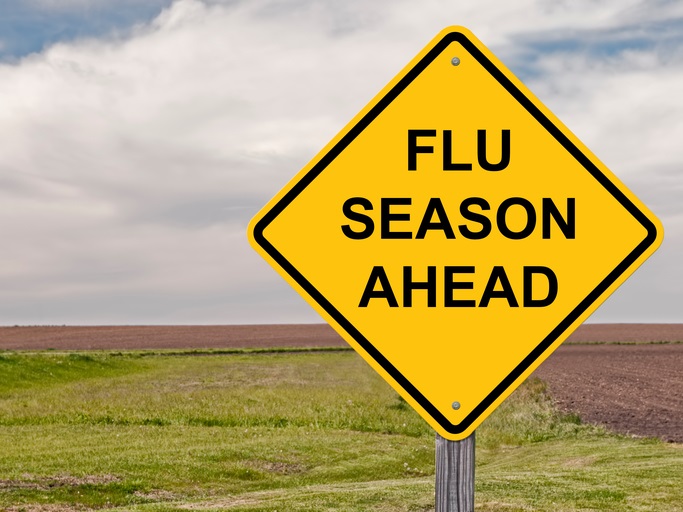The 2017-2018 flu season is upon us. And while it’s common to assume the information and advice is the same each year, the truth is, different strains of influenza change over time, and every season is different. According to our Chief Medical Officer Dr. Siegart, “It’s hard to predict exactly what travelers can expect this year, but here’s what we do know: organizations can play a pivotal role in educating their travelers on how to prevent the flu while fulfilling their duty of care and protecting traveler health and well-being in the process.”

Below, Dr. Siegart shares some insights and advice for travelers and their organizations specific to the 2017-2018 flu season:
Encourage prevention.
Annual vaccination remains the best way to protect against the flu and those in the Northern Hemisphere who are 6 months and older should get a flu vaccine every year by the end of October, before the U.S. flu season is in full swing. In the U.S., peak flu season usually ends by February. Travelers should get vaccinated at least 2 weeks before travel takes place because it takes that long for immunity to develop after vaccination. There are two types of flu vaccines, trivalent and quadrivalent, and both are approved for different age groups. There are no variations between the two vaccines in regard to safety or side effects, but the trivalent protects against three influenza viruses, whereas the quadrivalent protects against four. Those who are unsure which vaccination is best suited for them should consult with a trusted medical professional. In addition to getting a seasonal flu vaccine, travelers can take everyday preventive actions like staying away from sick people, not touching their eyes, nose or mouth (these are areas where contaminants containing the active influenza virus can enter) and frequently washing their hands to reduce the spread of germs. If soap and water are not available, using an alcohol-based hand sanitizer that contains at least 60% alcohol is acceptable. Carrying disinfectant wipes is also a great way to clean germ-prone surfaces like the airplane’s seatback trays and hotel door knobs.
Watch out for ‘what’s new.’
All of the vaccines have been updated for the 2017–2018 season, so it is important for people to get vaccinated this year, even if they received the vaccination last year (or the year before, or the year before that…). The recommendation not to use the nasal spray flu vaccine (LAIV) was renewed for the 2017-2018 season, and the advice remains that only the injectable vaccines (flu shots) should be utilized. There are several special types of injectable vaccines available this season, including a high dose trivalent flu shot approved for the elderly, and an egg-free trivalent shot that is approved for people over age 18. New this year, are a a quadrivalent flu shot that is approved for people 4 years of age and older and a trivalent flu shot that has an ingredient to boost the effectiveness for people over 65 years of age. Additionally, pregnant women may now receive any licensed, recommended, and age-appropriate flu vaccine.
Understand the barriers to vaccination…
CDC’s flu vaccination coverage data found that about 41.7% of adults age 18 and older were vaccinated during the 2015-2016 flu season. With the annual flu vaccine being the most effective way to prevent the flu, there are still clearly some barriers to receiving the flu vaccination—for example, those who have contracted the flu in the past and believe the vaccine caused them to get the flu are much less likely to receive the flu vaccine.
…And educate accordingly.
The flu vaccine does not cause the flu! The viruses in the flu shot are killed, which means they cannot cause infection. However, travelers could experience some mild side effects such as soreness/muscle aches, headaches, and fever which can sometimes be mistaken for the flu. Mild side effects can begin soon after one receives the vaccine and last 1-2 days.
Know (and communicate) the facts.
Travelers could be even more susceptible to getting the flu because they’re coming into contact with more people than they normally would (think planes, public transportation, meetings, events, etc.), as well as potentially deviating from their healthy eating, exercise and sleep habits. While influenza can occur sporadically, it often occurs in clusters of people from common sources where they are in close proximity such as on airplanes, aboard ships, and in tour groups. Additionally, those with compromised immune systems and/or chronic medical conditions like heart disease, diabetes, asthma and neurological conditions, those 65 years or older, pregnant women, and young children are at even higher risk.
Take a global view.
Since travel can take us outside our home hemispheres, it’s important to keep tabs on global influenza activity. For example, in the Northern Hemisphere, flu season can begin as early as October, peaks in February, and can last as late as April or May. In the temperate regions of the Southern Hemisphere, flu activity typically occurs April through September; and, in the tropics, flu activity occurs throughout the year. People who have not gotten a flu vaccine for the current season and are traveling to parts of the world where flu activity is ongoing should get the vaccine to protect themselves during their trip. The World Health Organization (WHO) provides global influenza updates on its website.
Tie it all together.
Ensuring travelers have the right resources in place to cope with the flu is just as critical to fulfilling your duty of care as prevention itself (our travelers can contact us 24/7 to help locate a physician in their areas, or even a hospital if symptoms are severe). Providing travelers with an arsenal of emergency resources they can trust is critical in keeping them happy, healthy, and productive this flu season and beyond.
For more information on protecting your travelers’ health and well-being, contact us to learn more about our holistic travel risk management programs for your organization.


